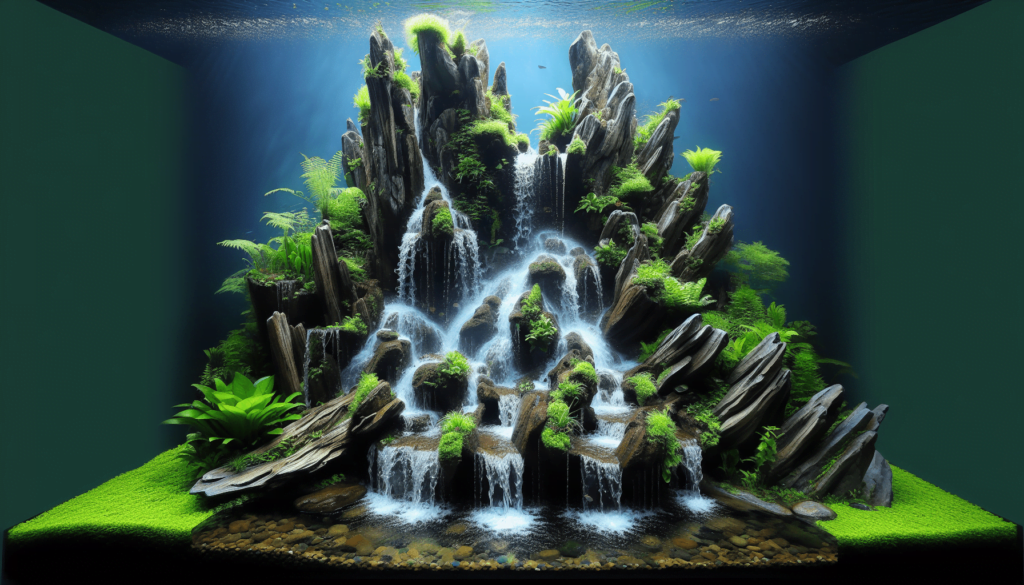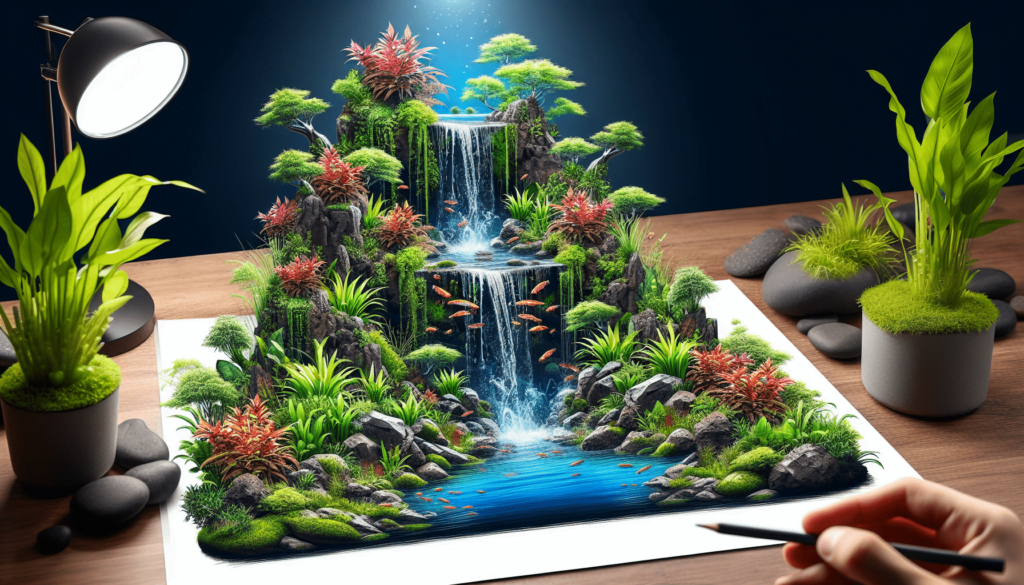Imagine you could bring a magical waterfall right into your own fish tank! In “Designing Dynamic Aquascaping Waterfalls,” you will learn how to create stunning underwater landscapes that look just like real waterfalls. You’ll find out how people have made these tiny waterfalls for their fish friends over the years and discover new and exciting ways to make your own. We’ll talk about everything you need to know, from the latest trends to the most helpful tips, so you can design a perfect aquatic world for your fish to enjoy. So let’s dive in and make something amazing together! Have you ever imagined creating a magical underwater landscape with sparkling waterfalls right in your own aquarium? Designing dynamic aquascaping waterfalls can bring your underwater world to life in a fun and wondrous way!

Overview
Aquascaping is like underwater gardening, but instead of flowers, you use rocks, driftwood, and aquatic plants. Adding a waterfall to your aquascape can make it even more enchanting and lively. Imagine watching tiny bubbles drifting down like glittering rain – isn’t that a delightful picture?
Thesis Statement
In this article, we will explore how to design dynamic aquascaping waterfalls, turning your aquarium into a mesmerizing underwater wonderland.
Historical Context
Long ago, people believed that water had magical powers. Babylonians had the Hanging Gardens, filled with lush greenery and flowing water. In Japan, Zen gardens often featured peaceful water elements. These historical garden designs inspire today’s aquascapers to create beautiful, moving water features in their aquariums.
Current Trends
Nowadays, many people are excited to bring this beauty into their homes. Adding waterfalls to aquariums is a growing trend. Folks love watching the water’s gentle flow and how it brings life and movement to their aquascapes. It’s like having a tiny, magical world in your living room!

Key Concepts and Definitions
Before we dive in, let’s make sure you understand some important terms:
- Aquascaping: Creating underwater landscapes in aquariums with plants, rocks, and other decorations.
- Waterfall: A feature where water flows down, creating a serene and beautiful effect.
- Substrate: The material at the bottom of the aquarium, like gravel or sand, where plants can grow.
- Filter: It keeps the water clean and helps with the flow of water.
Detailed Exploration
Let’s break down the process of designing your own dynamic aquascaping waterfall into easier steps.
Step 1: Planning Your Design
Think about how you want your underwater world to look. Do you want a big, bold waterfall or a small, gentle one? Draw some sketches or find pictures for inspiration.
Step 2: Choosing the Right Materials
Materials are essential. You need rocks or driftwood to create the structure. You might also need tubing and a small water pump to keep your waterfall flowing.
Step 3: Building the Structure
Arrange your chosen rocks or driftwood to form a slope. The water will flow down, creating the waterfall effect. Make sure the structure is stable so it doesn’t tumble down and stress the fish.
Step 4: Installing the Water Pump
A water pump will help move the water. Place the pump at the bottom and connect tubing to where you want the waterfall to start. The pump will push the water up, and gravity will bring it flowing down, creating a beautiful cascade.
Step 5: Adding Plants for a Natural Look
Adding plants around your waterfall makes it look even more natural. There are many aquatic plants to choose from, like Java Moss or Anubias.
Step 6: Maintaining the Waterfall
Regular maintenance is key to keep your waterfall and aquascape beautiful. Clean the pump and tubing to prevent clogs. Trim the plants so they don’t overgrow and hide your waterfall.

Example 1: Tropical Paradise Aquascape
Let’s look at an example called “Tropical Paradise.” Imagine a small aquarium filled with vibrant green plants and colorful fish. In one corner, a rocky slope is built using smooth stones. A tiny water pump hidden behind plants lifts the water up the slope, and it trickles down like a gentle stream.
Detailing the Example
In the “Tropical Paradise,” bright green Java Ferns sway with the movement of the water. Neon Tetras dart around, their colors reflecting off the water. The waterfall is a small but serene feature, bringing the entire aquascape to life.
Example 2: Mountain Stream Aquascape
Another example is the “Mountain Stream.” This one uses darker, rugged rocks to mimic a mountain landscape. A stronger water pump is used to create a more powerful and flowing waterfall.
Detailing the Example
In the “Mountain Stream,” hardy plants like Cryptocoryne grow between the rocks. The water flows more rapidly, mimicking a fast-moving mountain stream. Fish like Barbs, which enjoy swimming in strong currents, thrive in this setup.

Comparison of Different Perspectives
Some people love big, bold waterfalls with lots of movement, while others prefer small, gentle ones for a calmer effect. Both have their appeal, depending on what you enjoy and the type of fish and plants you have.
Bold Waterfalls
- Pros: More movement and excitement.
- Cons: Requires more powerful equipment and maintenance.
Gentle Waterfalls
- Pros: Calming and serene.
- Cons: Less movement, but easier to maintain.
Impact Assessment
Adding a dynamic waterfall to your aquascape can transform your aquarium into a lively and enchanting display. The moving water helps to oxygenate the tank, which is good for both fish and plants. It also creates a beautiful focal point for you and your visitors to enjoy.

Future Directions and Implications
Predictions
In the future, we might see even more innovative and creative aquascaping designs. Technology could bring new ways to create more realistic waterfalls, like energy-efficient pumps or materials that resemble natural elements more closely.
Implications
Creating and maintaining aquascapes with waterfalls helps us connect with nature, teaching us to appreciate and care for small ecosystems. It can also inspire creativity and bring a sense of tranquility to our homes.
Conclusion
Designing dynamic aquascaping waterfalls isn’t just about the beauty; it’s an incredible blend of art and science. By understanding the materials and techniques, you can create your own underwater masterpiece.
Recap
- Planning: Sketch your ideas and gather inspiration.
- Materials: Choose the right rocks, driftwood, and plants.
- Building: Create a stable and aesthetically pleasing structure.
- Pump Installation: Set up a water pump to keep the waterfall flowing.
- Maintenance: Regularly clean and trim to keep everything looking good.
Final Thought
Imagine your friends and family seeing your aquarium and hearing the gentle flow of water, like a tiny, magical forest in your home. Isn’t that something to dream about?
Engagement
Have you ever tried to create your own aquascaping waterfall? Share your thoughts and experiences in the comments below. Don’t forget to explore more resources if you’re eager to learn more about this exciting hobby!
Credible Sources
- Borne, Elena. “Aquascaping: A Guide to Tranquil Aquariums.” Green Thumb Publications, 2018.
- Smith, Derek. “Underwater Zen: The Art of Aquascaping.” New Wave Press, 2020.
- Waterscape Adventures. “How to Create Stunning Aquascaping Waterfalls.” Waterscape Adventures, September 2021.
Now, you’re ready to start designing your own dynamic aquascaping waterfalls. Have fun creating your underwater paradise!



